Fibrillin-1, induced by Aurora-A but inhibited by BRCA2, promotes ovarian cancer metastasis
- PMID: 25749384
- PMCID: PMC4466642
- DOI: 10.18632/oncotarget.3118
Fibrillin-1, induced by Aurora-A but inhibited by BRCA2, promotes ovarian cancer metastasis
Abstract
While Aurora-A (Aur A) provokes, BRCA2 restrains primary tumorigenesis, the roles of Aur A and BRCA2 in cancer metastasis remains unclear. Here, we show that the metastatic promoting markers SLUG, FBN1, and MMP2, 9, 13 are either stimulated or suppressed by Aur A or BRCA2, but the metastatic suppressors E-cadherin, β-catenin, and p53 are either inhibited or promoted by Aur A or BRCA2, leading to enhanced or reduced cell migration and invasion. Further study suggests that FBN1 inhibits E-cadherin and β-catenin, but stimulates MMP2, 9, 13. Depletion of SLUG abrogates FBN1 and MMP9, but increases E-cadherin, while p53 decreases both SLUG and FBN1. Animal assays demonstrate that FBN1 promotes both ovarian tumorigenesis and metastasis. Clinically, overexpression of BRCA2 or Aur A in ovarian cancer tissues predicts good or poor overall and disease free survivals. High expression of SLUG or FBN1 indicates poor overall survivals, whereas high expression of FBN1 but not of SLUG predicts poor disease free survival. No significant associations between p53 expression and patient survivals were found. Overall, FBN1, acts at the downstream of Aur A and BRCA2, promotes ovarian cancer metastasis through the p53 and SLUG-associated signaling, which may be useful for ovarian cancer diagnosis and treatment.
Keywords: Aurora-A; BRCA2; FBN1; SLUG; metastasis.
Figures
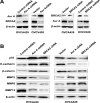
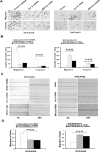
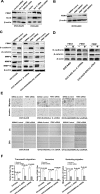

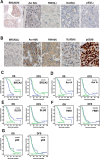
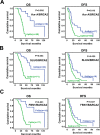

Similar articles
-
The negative interplay between Aurora A/B and BRCA1/2 controls cancer cell growth and tumorigenesis via distinct regulation of cell cycle progression, cytokinesis, and tetraploidy.Mol Cancer. 2014 Apr 28;13:94. doi: 10.1186/1476-4598-13-94. Mol Cancer. 2014. PMID: 24775809 Free PMC article.
-
Misregulation of polo-like protein kinase 1, P53 and P21WAF1 in epithelial ovarian cancer suggests poor prognosis.Oncol Rep. 2015 Mar;33(3):1235-42. doi: 10.3892/or.2015.3723. Epub 2015 Jan 15. Oncol Rep. 2015. PMID: 25592872
-
MicroRNA-222-3p/GNAI2/AKT axis inhibits epithelial ovarian cancer cell growth and associates with good overall survival.Oncotarget. 2016 Dec 6;7(49):80633-80654. doi: 10.18632/oncotarget.13017. Oncotarget. 2016. PMID: 27811362 Free PMC article.
-
Role of p53 and Rb in ovarian cancer.Adv Exp Med Biol. 2008;622:99-117. doi: 10.1007/978-0-387-68969-2_9. Adv Exp Med Biol. 2008. PMID: 18546622 Free PMC article. Review.
-
dUTPase in human neoplastic cells as a potential target for therapeutic intervention.Curr Protein Pept Sci. 2001 Dec;2(4):349-60. doi: 10.2174/1389203013381053. Curr Protein Pept Sci. 2001. PMID: 12369931 Review. No abstract available.
Cited by
-
Differentially expressed glycoproteins in pre- and post-digital rectal examination urine samples for detecting aggressive prostate cancer.Proteomics. 2023 Apr;23(7-8):e2200023. doi: 10.1002/pmic.202200023. Epub 2023 Jan 26. Proteomics. 2023. PMID: 36479985 Free PMC article.
-
RPS7 inhibits colorectal cancer growth via decreasing HIF-1α-mediated glycolysis.Oncotarget. 2016 Feb 2;7(5):5800-14. doi: 10.18632/oncotarget.6807. Oncotarget. 2016. PMID: 26735579 Free PMC article.
-
Predictors and Modulators of Synthetic Lethality: An Update on PARP Inhibitors and Personalized Medicine.Biomed Res Int. 2016;2016:2346585. doi: 10.1155/2016/2346585. Epub 2016 Aug 24. Biomed Res Int. 2016. PMID: 27642590 Free PMC article. Review.
-
Inhibition of the PIN1-NRF2/GPX4 axis imparts sensitivity to cisplatin in cervical cancer cells.Acta Biochim Biophys Sin (Shanghai). 2022 Aug 25;54(9):1325-1335. doi: 10.3724/abbs.2022109. Acta Biochim Biophys Sin (Shanghai). 2022. PMID: 35983979 Free PMC article.
-
Programmed death ligand 1 promotes lymph node metastasis and glucose metabolism in cervical cancer by activating integrin β4/SNAI1/SIRT3 signaling pathway.Oncogene. 2018 Jul;37(30):4164-4180. doi: 10.1038/s41388-018-0252-x. Epub 2018 Apr 30. Oncogene. 2018. PMID: 29706653
References
-
- Longuespee R, Boyon C, Desmons A, Vinatier D, Leblanc E, Farre I, Wisztorski M, Ly K, D'Anjou F, Day R, Fournier I, Salzet M. Ovarian cancer molecular pathology. Cancer Metastasis Rev. 2012;31:713–732. - PubMed
-
- Lassus H, Staff S, Leminen A, Isola J, Butzow R. Aurora-A overexpression and aneuploidy predict poor outcome in serous ovarian carcinoma. Gynecol Oncol. 2011;120:11–17. - PubMed
-
- Szabova L, Yin C, Bupp S, Guerin TM, Schlomer JJ, Householder DB, Baran ML, Yi M, Song Y, Sun W, McDunn JE, Martin PL, Van Dyke T, Difilippantonio S. Perturbation of Rb, p53, and Brca1 or Brca2 cooperate in inducing metastatic serous epithelial ovarian cancer. Cancer Res. 2012;72:4141–4153. - PMC - PubMed
Publication types
MeSH terms
Substances
LinkOut - more resources
Full Text Sources
Other Literature Sources
Medical
Research Materials
Miscellaneous

